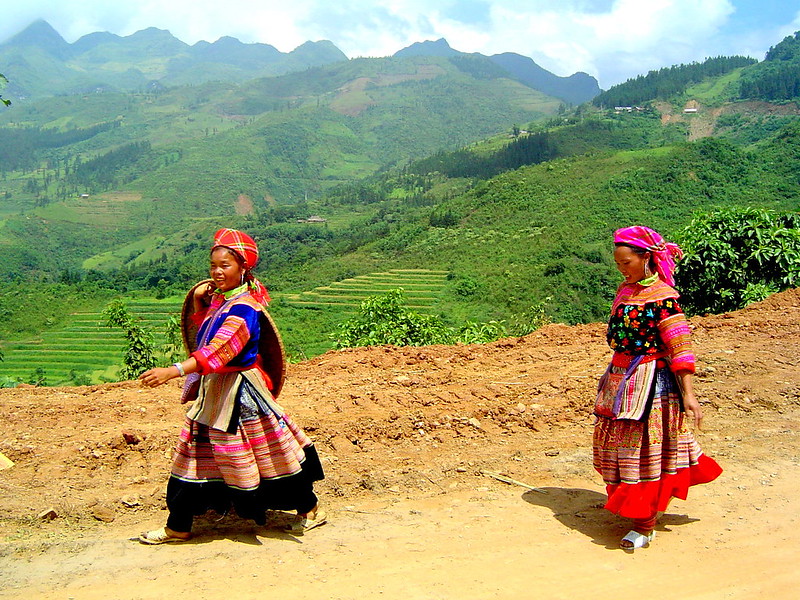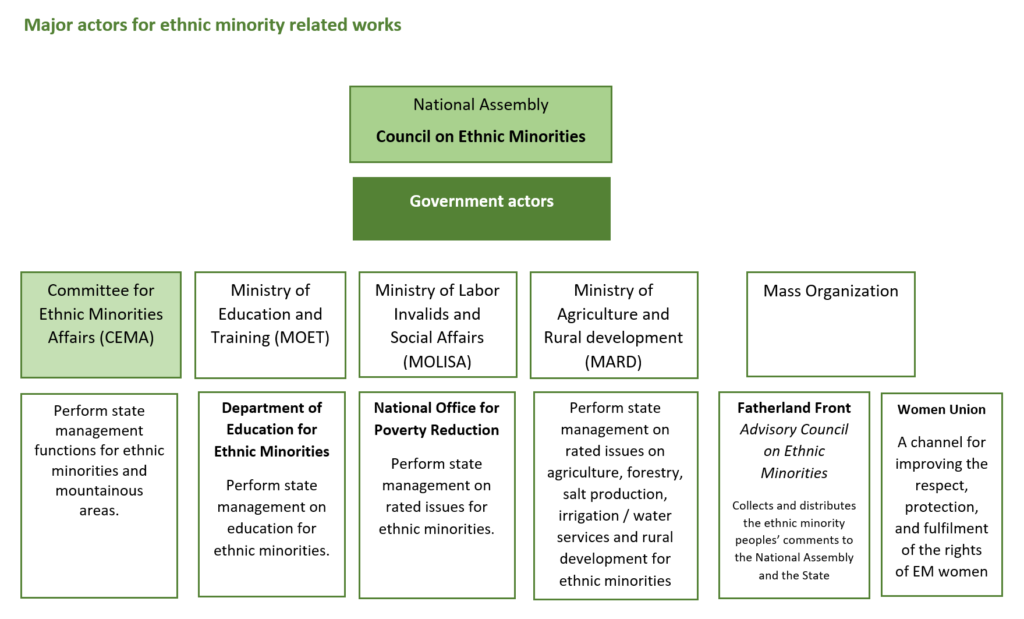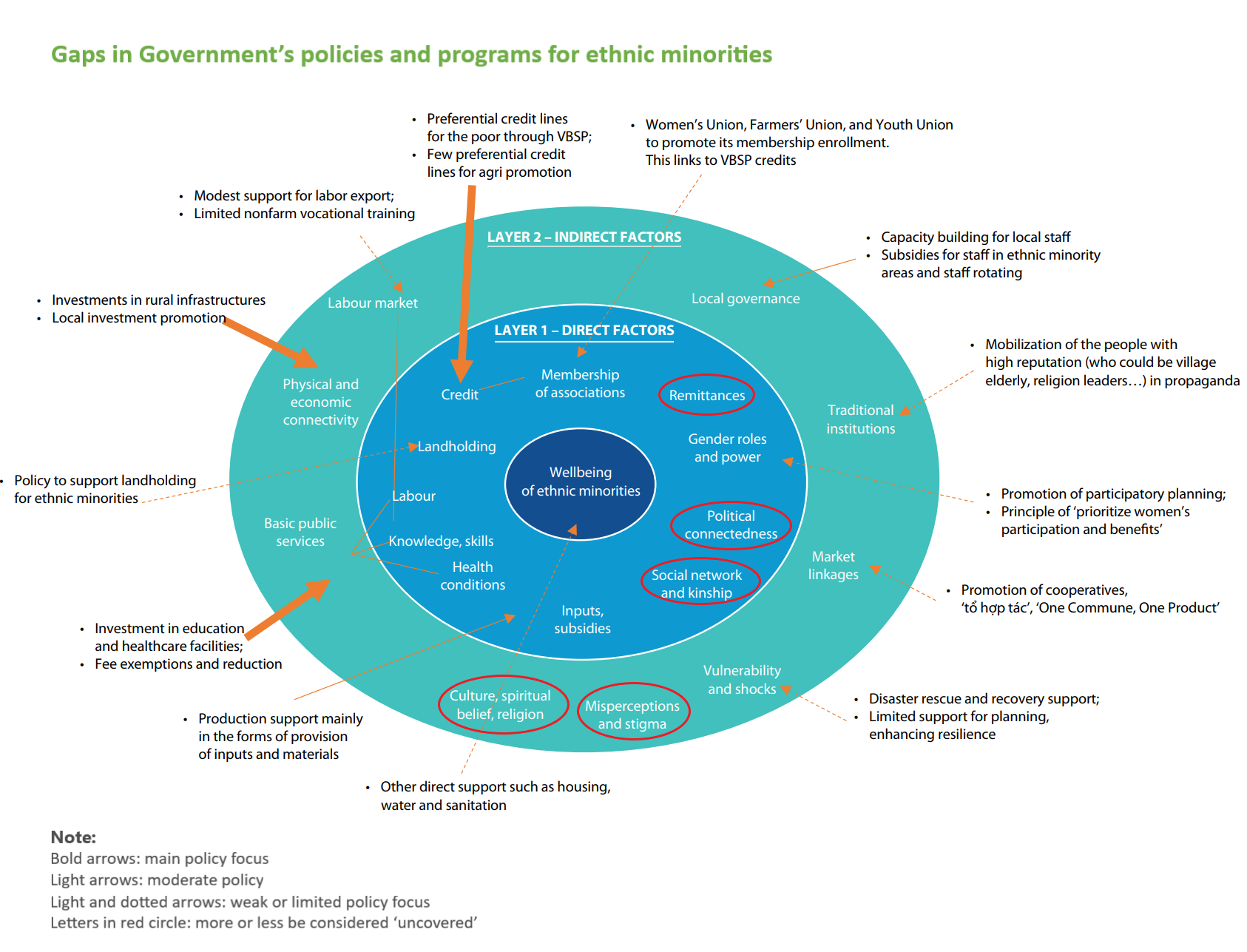Introduction
The Vietnamese Government recognizes 53 ethnic minorities1 Other counts suggest the existence of more than 90 groups, amounting to approximately 10 million people, or nearly 10% of Vietnam’s population.2 Most ethnic minorities inhabit remote areas of Vietnam and have their own belief systems which are heavily tied to land.

Hmong Girls walking from Bac Ha Market. Photo taken by Philip Turner. Licence under CC BY-NC 2.0.
The Government has introduced a system of policies to incorporate ethnic minorities in the national development process, amounting to over 100 legal documents enacted by more than 10 state authorities since the 1980s.3 The “Master Plan on Socio-economic Development of Ethnic Minorities and Mountainous Areas 2021-2030” unifies these policies.4 The implementation plan was issued by the Government in 20205 and the corresponding National Target Program is currently being drafted. However, there remain debates on whether these policies are representative of the needs of ethnic minorities.
Source: Created by ODM. Licensed under CC BY-SA 4.0.
Development philosophy
The Constitution of Vietnam recognizes the rights of ethnic minorities “to use their own language and writing, to preserve their ethnic identity and to nurture their fine customs, traditions and cultures”. Each person has “the right to self-identify ethnically, use their mother tongue and select language for communication”.
The main philosophy of the government’s approach to development for ethnic minorities remains unchanged since 1992: “Equality, solidarity, mutual assistance and inclusive development”.6 Current policy calls for comprehensive political, socio-economic and cultural development in mountainous areas.7 Sectoral priorities include transportation and infrastructure development, hunger elimination and poverty reduction, environmental protection, human resource and cultural development, and asset-based community development.8
Consultation with ethnic minorities is technically available, but these processes are not easily accessible for all ethnic minorities.
Development objectives with reference to SDGs
The Government of Vietnam’s Committee for Ethnic Minorities Affairs (CEMA)9 has identified specific targets to help achieve the SDGs.10 However, research11 suggests that these targets ambitious. The 2019 survey on the socio-economic situation of 53 ethnic minority groups of Vietnam (with results expected in 2020) may help provide further guidance.
Key policy packages
The CEMA, a ministerial-level agency, is responsible for unified state management of ethnic affairs in Vietnam. CEMA has line agencies in most of the provinces and in geographically strategic areas or areas with an ethnic minority population of 5000 or more. CEMA has representatives down to the district-level.12 The state level agency requires a minimum representation of ethnic people. However, at commune level, qualitative analysis indicates that despite a relatively high presence of ethnic minorities, most key positions are held by the Kinh with higher qualification. This might put ethnic minorities at a disadvantage in terms of access to resources available from policies and other external support in communes or villages, as well as limiting the strength of their voice.13
The Government’s most recent policy on ethnic minorities, released in 2016, is the “Decision on Typical Support Policies for Socio-economic Development of Ethnic Minorities and Mountainous Areas 2017-2020”.14 In addition, a series of National Target Programs for Poverty Reduction have been implemented, in which ethnic minorities are the main beneficiary group (Program 13415Program 135 phase 116 and phase 2,17 Program 30a18 and the National Target Program for 2016-202019).Recently, the NTP on New Rural Development also addresses the ethnic minorities in remote mountainous areas. The overall objective of these policies is to foster sustainable poverty reduction and narrow the gaps between ethnic regions and other regions of the country while protecting and preserving ethnic cultures and customs.
The Government’s policies and programs cover a wide range of themes:
- Livelihood and poverty reduction: shifting communities from their traditional nomadic lifestyles to one that is sedentary, forest land allocation, credit and subsidy
- Human resource development: school fee exemption, preventive healthcare promotion and nutrition improvement, gender equality, promotion of ethnic leaders in the community and government authorities at all levels)
- Cultural development: village cultural house, traditional product commercialization, cultural assets stock-taking.
- Infrastructure development: essential infrastructure including schools, clinics, roads, bridges, electricity grid, irrigation construction, wholesale and retail markets, telecommunication systems.
- Science and technology application: Application of science technology, especially information technology, communication, capacity building (online learning, e-library, etc.).
The support has resulted in some improvements in living standards in ethnic minority areas, notably: physical connectivity, access to public services (education and healthcare), housing conditions, and access to public utilities (electricity, drinking water). However, there is not much progress in production support, capacity building, cultural development, promoting their voice, and increasing ethnic minority participation in community development.20For instance, Kinh culture and history still dominate in standard textbooks which are available only in Vietnamese. 21Large-scale dam projects and agro-industrialisation for commercial cropping have a significant impact on forest ecosystems, and associated reallocations of land have pushed ethnic minorities from a forest lifestyle to sedentary agriculture and agro-forestry production. The approach of land allocation has neglected the importance of collective forest use for religious and traditional practices of ethnic minorities.22 The donor community, as well as the government, have raised concerns about these programs, including that they may be top-down,23not based on a full understanding of ethnic minority cultures and religions,24 developed without adequate consultation with ethnic minority representatives,25overlapping,26 and inefficiently and inadequately implemented. Other critics consider that these subsidy-oriented programs do not enable ethnic minorities the right to self-determination. 27, 28 There remain large income and opportunity gaps among ethnic minorities compared to the majority Kinh people, which the Government aims to address.29
Source: World Bank. 2019. “Drivers of Socio-Economic Development Among Ethnic Minority Groups in Vietnam”.
For ethnic minorities, these programs can have real day-to-day consequences. The COVID-19 pandemic has highlighted these results. For instance, a high dependence on agricultural production and low accessibility to policy benefits limits the ability of ethnic minority communities to recover from shocks. Because the pandemic has caused agricultural trade to slow down30 and informal employment to disappear,31 the resulting food insecurity and sudden poverty will be difficult for ethnic minorities to bear. In addition, the digital divide between the ethnic minority and majority people is magnified by the Government’s heavy reliance of internet and digital tools for maintaining business and education and other COVID-19 response measures.
References
- 1. The Government of Vietnam refers to “ethnic minorities” instead of “indigenous people”, although it voted in favour of the UN Declaration on the Rights of Indigenous People.
- 2. Asia Indigenous Peoples Pact. 2014. “Overview of the State of Indigenous Peoples in Asia”. Accessed April, 2020.
- 3. National Assembly of the Socialist Republic of Vietnam (web portal). “Perspectives from delegates: Promote comprehensive development of ethnic minority areas”. Accessed April, 2020.
- 4. The Parliament of Vietnam. 2019. “Resolution 88/2019/QH14 on approving Master Plan on Socio-economic development of Ethnic Minorities and Mountainous areas 2021-2030”. Accessed April, 2020.
- 5. The Socialist Republic of Vietnam. 2019. “Resolution 12/NQ-CP on implementation plan to the Master Plan on Socio-economic development of Ethnic Minorities and Mountainous areas 2021-2030”. Accessed April, 2020.
- 6. The Socialist Republic of Vietnam. 2013. “Constitution.” Accessed April, 2020.
- 7. The Socialist Republic of Vietnam. 2011. “Decree 05/2011/ND-CP of Prime Minister on Ethnic works”. Accessed April, 2020.
- 8. The Socialist Republic of Vietnam. 2013. “Decision 449/QĐ-TTg of Prime Minister approving the ethnic minority affairs strategy through 2020”. Accessed April, 2020.
- 9. CEMA is a ministerial-level government body, in charge of management functions for ethnic minorities and mountainous areas.
- 10. The Socialist Republic of Vietnam. 2015. “Decision No 1557/QĐ-TTg of Prime Minister on approving a number of MDG indicators for ethnic minorities associated with the SDGs after 2015”. Accessed April, 2020.
- 11. PhD. Phung Duc Tung, PhD. Nguyen Viet Cuong, PhD. Nguyen Cao Thinh, Nguyen Thi Nhung, and Ta Thi Khanh Van (2017), “Overview of social economic situation – Results from analyses of the survey on the socio-economic situation of 53 ethnic minorities in 2015”, Accessed on May 2018.
- 12. The Socialist Republic of Vietnam. 2015. “Decree 53/2004/NĐ-CP dated 18/2/2004 on organisational consolidation of the ethnic affairs apparatuses under the people’s committees of all levels.” Accessed May, 2020.
- 13. World Bank. 2019. “Drivers of Socio-Economic Development Among Ethnic Minority Groups in Vietnam”. Accessed April, 2020.
- 14. The Socialist Republic of Vietnam. 2016. “Decision No 2085/QĐ-TTg of Prime Minister on typical support policies for socio-economic development of Ethnic Minorities and Mountainous area 2017-2020”. Accessed April, 2020.
- 15. The Socialist Republic of Vietnam. 2004. “Decision No 134/2004/QĐ-TTg of Prime Minister on support for production land, residential land, housing and water for disadvantaged ethnic minority”. Accessed April, 2020.
- 16. The Socialist Republic of Vietnam. 1998. “Decision No 135/1998/QĐ-TTg of Prime Minister on the Program for the Socio-Economic Development of Extremely Difficult Communes in Ethnic, Mountainous, Boundary and Remote Areas”. Accessed April, 2020.
- 17. The Socialist Republic of Vietnam. 2006. “Decision No 07/2006/QĐ-TTg of Prime Minister on the Program for the Socio-Economic Development of Extremely Difficult Communes in Ethnic, Mountainous, Boundary and Remote Areas 2006-2010”. Accessed April, 2020.
- 18. The Socialist Republic of Vietnam. 2008. “Resolution 30a/2008/NQ-CP on Program to support rapid and sustainable poverty reduction in 61 poor districts”. Accessed April, 2020.
- 19. The Socialist Republic of Vietnam. 2016. “Decision 1722/QĐ-TTg on National Target Programme for Sustainable Poverty Reduction 2016-2020”. Accessed April, 2020.
- 20. World Bank. 2019. “Drivers of Socio-Economic Development Among Ethnic Minority Groups in Vietnam”. Accessed April, 2020.
- 21. Baulch, Bob; Truong Thi Kim Chuyen; Haughton, Dominique; Haughton, Jonathan. 2002. “Ethnic minority development in Vietnam : a socioeconomic perspective.” Policy, Research working paper series ; no. WPS 2836. Washington, DC: World Bank. Accessed April, 2020.
- 22. CIRUM. 2011. “The role of customary law and practices in forest and water resources management and use.” Accessed April, 2020.
- 23. Hai-Anh Dang. 2012. “Vietnam: A Widening Poverty Gap for Ethnic Minorities” in Gillette Hall and Harry Patrinos. (Eds.) “Indigenous Peoples, Poverty and Development”. Cambridge University Press, Forthcoming. Accessed April, 2020.
- 24. Asia Indigenous Peoples Pact. 2015. “Indigenous People in Asia: Vietnam”. Accessed April, 2020 .
- 25. CEMA, UNDP. 2012. “Situation and policy recommendation for land management and use in ethnic minority and mountainous ares – Brief report.” Accessed April, 2020.
- 26. Benjamin, D., Brandt, L., McCaig, B. and Le Hoa, N. 2018. “Program participation in a targeted land distribution program and household outcomes: evidence from Vietnam.” Review of Economics of the Household, 16(1), pp. 41-74. Accessed April, 2020.
- 27. PhD. Phung Duc Tung, PhD. Nguyen Viet Cuong, PhD. Nguyen Cao Thinh, Nguyen Thi Nhung, and Ta Thi Khanh Van.2017., “Overview of social economic situation – Results from analyses of the survey on the socio-economic situation of 53 ethnic minorities in 2015”, Accessed on May 2018.
- 28. Asia Indigenous Peoples Pact. 2015. “Indigenous People in Asia: Vietnam”. Accessed April, 2020 .
- 29. Kozel, Valerie J.. 2014. “Well begun but not yet done : progress and emerging challenges for poverty reduction in Vietnam.” Washington, DC ; World Bank Group. Accessed April, 2020.
- 30. Vietnam News. 2020. “Farm produce prices slump as Covid-19 hits exports” . Accessed April, 2020.
- 31. Customs News. 2020. “Millions face jobs loss as employment market feels Covid-19 effects”. Accessed April, 2020.



